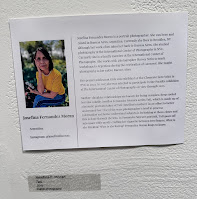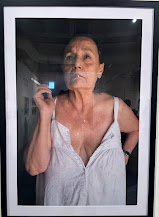GALLERY RESPONSE ESSAY
Curatorial activism can be expressed in many different ways. In Towards a Curatorial Activism by Dr. Maura Reilly, she states on page 10 that “On investigating price differentials, and sex–race ratios in galleries, within thematic and national exhibitions, and in the press, the numbers demonstrate that the fight for equality is far from over. Indeed, the more closely one examines art world statistics, the more glaringly obvious it becomes that, despite the decades of postcolonial, feminist, anti-racist, and queer activism and theorizing, the ‘majority’ continues to be defined as white, Euro-American, heterosexual, privileged and, above all, male. When perusing the majority of mainstream museums, for instance, one must search more diligently for the women artists, artists of colour, and artists of non-Euro-American descent.” I feel like it talks about many different issues going on and wraps them up in a very nice way. It is crazy to me that we're still fighting to have equal opportunities for everyone in every community, even the art world. Even though this quote was relatively early in the reading it felt pivotal to me because it made me want to keep reading since she didn’t sugar coat her opinions. Art is about learning from others' perspectives, point of views in different ways of doing things and the only way in which to do that is to have different things shown from different people. Reilly also explains that ‘“Curatorial Activism” is a term I use to designate the practice of organizing art exhibitions with the principle aim of ensuring that certain constituencies of artists are no longer ghettoized or excluded from the master narratives of art.” As someone who wasn’t familiar with topics like this and someone who is usually not around as public activism it was good to have this sort of definition to refer to. Curatorial activism can be defined by simply intentionally changing the stereotypical look of an exhibition. Everyone should have a place in which they can show their work and have equal opportunities as everyone else does. This idea seems to help get away from that typical narrative that we see in the world today.
Activism is simply someone wanting to create change. Before you can act on anything you have to decide what needs to change. For Kimberly Drew, she expressed it in a book; in This Is What I Know About Art, she says “I wasn't at work or hustling to art events for free food, I continued to cultivate my blog. It was my refuge. The more art I saw, the more I wanted to share it with others,” on page 33. Everyone needs an outlet, a safe space in order to be yourself and share what you want the world to know about you. It is necessary for everyone to have this safe space no matter what you are into or what you are. This safe space is where you can tailor everything to yourself and everything can be only about you. This part in the reading was pivotal to me because she started to have a sense of what she needed and wanted to change. Drew also exclaims, “As time went on, I also realized that I didn't get many opportunities to learn about the artists and movements that got me interested in art in the first place. There have been black people since the beginning of time, but I was not seeing any of their art in any of my classes,” on page 20. Its crazy to think some people still teach like that. Not everyone is interested in the same thing. Different types and styles of art from different people is what truly helps people learn and decipher what they truly are interested in. Only seeing one kind of art is what you are going to think is the only kind of art, seeing different things is what makes people have different interests and that is how we are able to learn from each other. If we all saw the same kind of art then nothing would be different, everything would be very bland.
In Understanding Patriarchy by Bell Hooks ideas of patriarchal norms are shared, this relates to the topic of activism because she wanted and worked towards changing the patriarchy. Hooks states, “I was always more interested in challenging patriarchy than my brother was because it was the system that was always leaving me out of things that I wanted to be part of.” During this part of the passage they talk about the differences growing up in a patriarchal household, brother to sister. Growing up my life was nothing like the author went through, I have an older sister and even with the “feminine roles” we never followed anything. The author also explains how she wasn't allowed to play a game with marbles because it was masculine, said her father. My favorite movie was and still is Disneys Cars; if I were to have wanted a toy growing up I would have gotten it no questions asked because there would have been no thought of “she can't have that, it's not feminine.”
Part 2 - Art Example
The exhibition Lente Latine/Latin Lens, was a great way at expressing different cultures and ideas. All of the artists used photography to capture something they were passionate about both of the people that I have picked both photographed photos of their parents. I picked these pieces because I felt like I could relate to them.
Josefina Fernandez Moran Title: Titi 2015 Photography
Josefina Fernandez Moran Is a portrait photographer from Argentina who now lives in Brooklyn. Her work depicts her mother smoking a cigarette looking off into the distance. She says that she took these photos in hopes to better understand her mother. A photo tells a thousand stories, what was she looking at? What did she do moments after? These are things that a photo like this makes us think. We can all relate to seeing someone in this kind of state of what they are doing and wanting to know more about it. This form of activism is a great way of showing an artist that may or may not have gotten the chance to be seen somewhere else due to their ethnicity.
Gabriel Garcia Roman Title: I Am My Father’s Son 2016 Vinyl
This is the work of Garcia Roman; he is a artist and Craftsman who does work mainly on identity pieces through intricate designs. In this particular piece he depicts a photo of him and his late father blended together through weaving. Showing that although there are many differences there are also many similarities.
Work Cited
Drew, Kimberly (2020)This Is What I Know About Art
Hooks, Bell Understanding Patriarchy
Reilly, Maura In Towards a Curatorial Activism
Moran, Josefina (2015) Titi
Roman, Gabriel Garcia (2016) I Am My Father’s Son




No comments:
Post a Comment